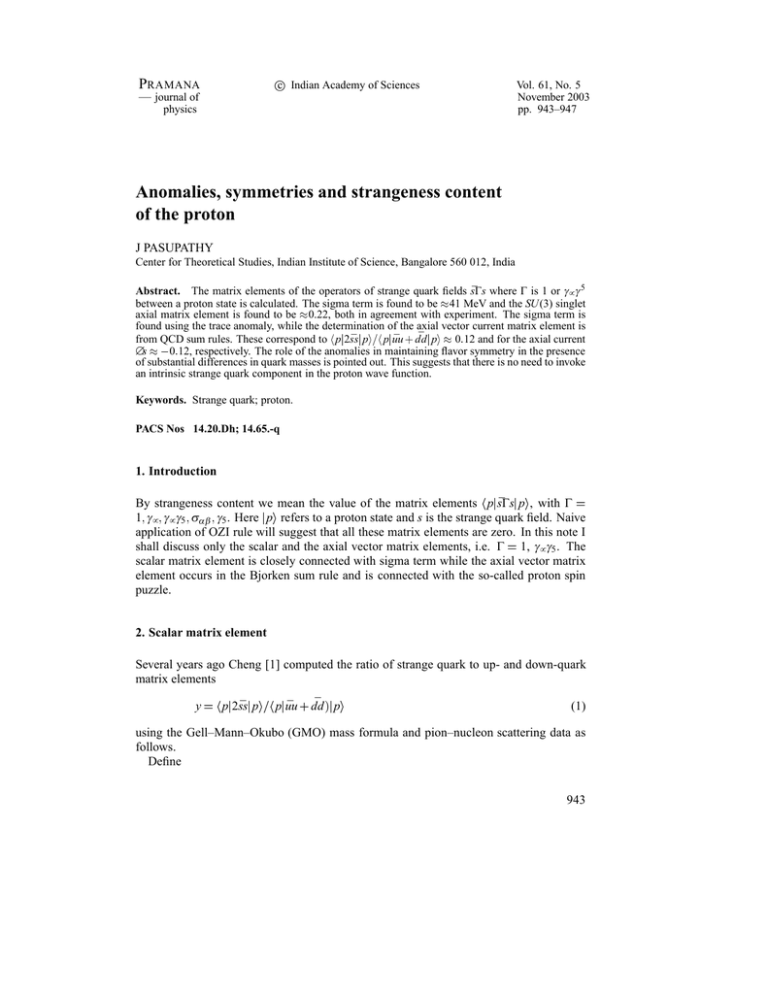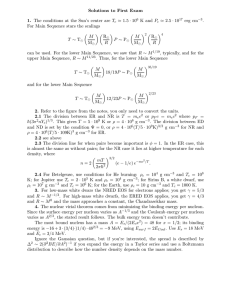Anomalies, symmetries and strangeness content of the proton P —
advertisement

PRAMANA — journal of ­c Indian Academy of Sciences physics Vol. 61, No. 5 November 2003 pp. 943–947 Anomalies, symmetries and strangeness content of the proton J PASUPATHY Center for Theoretical Studies, Indian Institute of Science, Bangalore 560 012, India Abstract. The matrix elements of the operators of strange quark fields s̄Γs where Γ is 1 or γµ γ 5 between a proton state is calculated. The sigma term is found to be 41 MeV and the SU(3) singlet axial matrix element is found to be 0.22, both in agreement with experiment. The sigma term is found using the trace anomaly, while the determination of the axial vector current matrix element is ¯ p 012 and for the axial current from QCD sum rules. These correspond to p2s̄s p pūu dd ∆s 012, respectively. The role of the anomalies in maintaining flavor symmetry in the presence of substantial differences in quark masses is pointed out. This suggests that there is no need to invoke an intrinsic strange quark component in the proton wave function. Keywords. Strange quark; proton. PACS Nos 14.20.Dh; 14.65.-q 1. Introduction By strangeness content we mean the value of the matrix elements ps̄Γs p, with Γ 1 γµ γµ γ5 σαβ γ5 . Here p refers to a proton state and s is the strange quark field. Naive application of OZI rule will suggest that all these matrix elements are zero. In this note I shall discuss only the scalar and the axial vector matrix elements, i.e. Γ 1, γµ γ5 . The scalar matrix element is closely connected with sigma term while the axial vector matrix element occurs in the Bjorken sum rule and is connected with the so-called proton spin puzzle. 2. Scalar matrix element Several years ago Cheng [1] computed the ratio of strange quark to up- and down-quark matrix elements ¯ p y p2s̄s p pūu dd (1) using the Gell–Mann–Okubo (GMO) mass formula and pion–nucleon scattering data as follows. Define 943 J Pasupathy σ pm̂ ūu dd¯ p m̂ mu md 2 (2) Write the strong interaction Hamiltonian as Hstrong Ĥ0 Hm (3) where Ĥ0 is the QCD Hamiltonian obtained when all quark masses are set equal to zero and [2] ¯ ms s̄s Hm mu ūu md dd (4) Let us ignore the up- and down-quark mass differences and set mu md then write the mass term as a singlet plus octet Hm 1 ¯ s̄s 1 ms m̂ūu dd ¯ 2s̄s ms 2m̂ūu dd 3 3 m̂. We can (5) From the Gell–Mann–Okubo mass formula then we derive ms m̂ūu dd¯ 2s̄s p mΞ mΛ Now use ms m̂ 2MK2 Mπ2 1 25 to get σ 1 y 26 MeV 1 p 3 (6) (7) To determine σ in eq. (2) one uses the pion–nucleon scattering data. Using low-energy theorems of current algebra, one has the relation Fπ2 T ν 0 t 2m2π σ t 2m2π (8) where T is the isoscalar amplitude, ν is the energy and t is the momentum transfer. Using the phase shift data, sigma can be determined (see [3]) σ t 2m2π 60 MeV (9) If we neglect the t-dependence of sigma, then combining eq. (7) with eq. (9) we find a rather large value for y 057 which more over would suggest that most of the nucleon’s mass is contributed by the strange quark, a rather strange conclusion. By now it is understood that there are important corrections to Cheng’s discussion. First there are corrections to GMO mass formula which have been computed by Gasser and 3 2 Leutwyler Omq [4] and by Borasoy and Meisner Om2q [5]. Sainio [6] has summarized these corrections as σ̂ σ 1 y 36 7 MeV (10) Cheng also ignored the fact that the scalar matrix element derived from the pion–nucleon data corresponds to a value of t 2m2π and should be continued to t 0. This was done by Gasser et al [3], who obtained the value σ σ t 0 45 MeV. Combining with eq. (10) one has y 02 substantially smaller than Cheng’s initial determination. 944 Pramana – J. Phys., Vol. 61, No. 5, November 2003 Anomalies, symmetries and strangeness content of the proton Here I shall give an update of an elementary determination [7] of σ and y using the trace anomaly. Let Θνµ be the energy–momentum tensor. Its trace has an anomaly [8] Θαα 11 23 NF 8απs Gaµν Gaµν muūu md dd¯ md dd¯ ms s̄s mcc̄c mbb̄b mt t¯t (11) We have the equation for the mass α pΘα p mp (12) which is an exact relation. (This follows from writing the most general matrix element of Θµν and using the fact that Θ00 is the Hamiltonian density.) Now by the decoupling theorems, one expects the proton mass to be unchanged if we remove a heavy quark from the QCD Lagrangian [9]. Writing G2 αs a a µν pG µν G p 8π (13) decoupling of heavy quarks in eq. (11) leads to: 23G2 mh ph̄h p 0 for h t b c (14) Suppose we assert that the strange quark also decouples in a similar manner, then we obtain ms ps̄s p 23G2 (15) from which using eq. (1) we get σ y 4 m̂ 2 G 3 ms (16) We can now write σ 1 y σ 475 G2 36 MeV (17) On the other hand, using eq. (11) we have from the nucleon mass σ 293G2 938 MeV (18) Solving for G2 we find σ 41 MeV (19) and G2 93 MeV We get a value of y 012, which shows that strange quark matrix element is non-zero by virtue of its coupling to the gluon field. These values of σ and y are consistent with those of ref. [6] within errors. It would be surprising if strange quark decouples precisely according to eq. (15). More precise determination of y will decide whether strange quark in fact decouples exactly like heavy quarks or not. Pramana – J. Phys., Vol. 61, No. 5, November 2003 945 J Pasupathy 3. Axial vector matrix element The first point to note is that the Ellis–Jaffe sum rule [10] is internally inconsistent. On the one hand it assumes the validity of flavor SU(3) symmetry and on the other it sets the matrix element of strange quark to zero by a naive application of OZI rule. As pointed out by Gross et al [11], the large differences in the quark masses would lead to large violations of flavor symmetry in the Bjorken sum rule if the anomaly is neglected. Bearing this in mind, the matrix element of the isoscalar combination p sūγµ γ5 u d¯γµ γ5 d p s (20) was evaluated by Gupta et al [12] by the QCD sum rule method. The details can be found in [12]. Define p sq̄γσ γ5 q p s ∆q µ 2sσ with q u d s (21) where sσ is the covariant spin vector and µ is the renormalization scale. aI 0; µ 2 sσ a8 sσ ∆u ∆d sσ ∆u ∆d 2∆ssσ (22) (23) and the SU(3) singlet Σµ 2 sσ ∆u ∆d ∆ssσ (24) Gupta et al [12] found the value of iso-singlet in eq. (22) to be aI 0; µ 2 035 substantially different from a8 flavor singlet (25) 058. It corresponds to ∆s 012 and for the SU 3 Σµ 2 022 (26) As in all old QCD sum rule calculations, the numbers in ref. [12] were obtained using a low value of Λ 100 MeV and µ 500 MeV. We shall return elsewhere to a thorough re-analysis of ref. [12] but, for the present, note that simple change of Λ to 250 MeV and µ to 1 GeV marginally increases the value of a. We also note that experimentally Σ is substantially lower than a8 which is in conflict with Ellis and Jaffe [10]. Anthony et al [13] determined Σ to be 018 009, while Abe et al [14] arrived at an average value of 030. The difference arises in the extrapolation procedures used by them to determine the low x distribution functions. 4. Anomalies and flavor symmetry As mentioned earlier, it was pointed out by Gross et al [11], that if the anomaly is ignored, one should expect large violations of isospin in the Bjorken sum rule. In particular, setting the anomaly to zero, they derived the relation 946 Pramana – J. Phys., Vol. 61, No. 5, November 2003 Anomalies, symmetries and strangeness content of the proton ūγµ γ5 u d¯γµ γ5 d N I 1 mu md N ∂ µ ūγµ γ5 u d¯γµ γ5 d N I 1 mu md N ∂ µ (27) where the subscript I 1 on the nuclear matrix elements denotes the difference between proton and neutron matrix elements, mu md and further mu md mu md O1 (28) Equation (27) implies large violation of isospin invariance in Bjorken sum rule. The lefthand side of eq. (27) should be zero or nearly so if isospin is a good symmetry while the right-hand side is far from zero. This erroneous conclusion disappears if anomaly is taken into account, as shown in ref. [11]. Turning now to the scalar matrix element, again if we set the anomaly to zero we have α pΘα p pmu ūu md dd¯ mss̄s p m p (29) Inserting the phenomenological numbers found by Sainio [6], σ 45 MeV and y 02. The left-hand side is seen to be just 158 MeV far short of the nucleon mass. Alternately, without using the value of σ one can write equations identical to eq. (29) for proton for Σ by replacing d by s and for Ξ by replacing u by s and solving the resulting ¯ s̄s elements. One finds the term mu ūu md dd ¯ contributes 94 MeV equations for ūu dd while ms s̄s contributes 894 MeV for the proton mass! 5. Conclusion Anomalies play a crucial role in maintaining flavor symmetry. Since strange quark mass is still small by the scale of strong interactions, a substantial coupling to the nucleon is possible via the gluon field anomaly both in the scalar and axial vector case. References [1] T P Cheng, Phys. Rev. D13, 2161 (1976) [2] An integral over d3 x is implicit. Because of translation invariance, diagonal matrix elements are independent of x [3] J Gasser, H Leutwyler and M E Sainio, Phys. Lett. B253, 252 (1991) [4] J Gasser and H Leutwyler, Phys. Rep. 8, 77 (1982) [5] B Borasoy and U-G Meisner, Ann. Phys. (NY) 25, 192 (1997) [6] M E Sainio, π N Newsletter 16, 138 (2002) [7] J Pasupathy, Proc. Int. Seminar on Direct Nuclear Reactions edited by N G Puttaswamy (Indian Academy of Sciences, Bangalore, 1989) p. 17 [8] J Collins, A Duncan and S Joglekar, Phys. Rev. D16, 438 (1977) [9] M Shiffman, A Vainshtein and V I Zakharov, Phys. Lett. B78, 443 (1978) [10] J Ellis and R L Jaffe, Phys. Rev. D9, 1444 (1974) [11] D J Gross, F Wilczek and S B Treiman, Phys. Rev. D19, 2188 (1979) [12] S Gupta, M V N Murthy and J Pasupathy, Phys. Rev. D39, 2547 (1989) C B Chiu, J Pasupathy and S L Wilson, Phys. Rev. D32, 1786 (1985) [13] P L Anthony et al, Phys. Lett. B463, 339 (1999) [14] K Abe et al, Phys. Rev. D58, 112003 (1998) Pramana – J. Phys., Vol. 61, No. 5, November 2003 947






